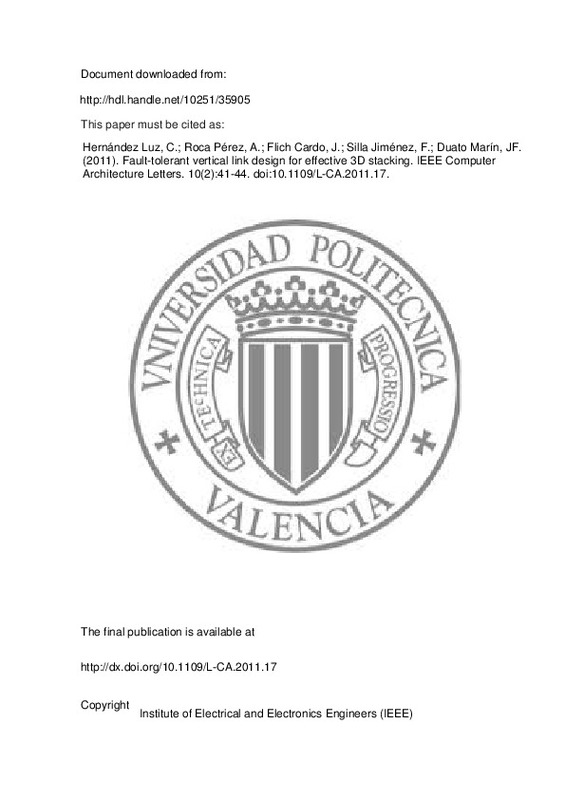JavaScript is disabled for your browser. Some features of this site may not work without it.
Buscar en RiuNet
Listar
Mi cuenta
Estadísticas
Ayuda RiuNet
Admin. UPV
Fault-tolerant vertical link design for effective 3D stacking
Mostrar el registro sencillo del ítem
Ficheros en el ítem
| dc.contributor.author | Hernández Luz, Carles
|
es_ES |
| dc.contributor.author | Roca Pérez, Antoni
|
es_ES |
| dc.contributor.author | Flich Cardo, José
|
es_ES |
| dc.contributor.author | Silla Jiménez, Federico
|
es_ES |
| dc.contributor.author | Duato Marín, José Francisco
|
es_ES |
| dc.date.accessioned | 2014-02-24T08:29:39Z | |
| dc.date.issued | 2011-12 | |
| dc.identifier.issn | 1556-6056 | |
| dc.identifier.uri | http://hdl.handle.net/10251/35905 | |
| dc.description.abstract | [EN] Recently, 3D stacking has been proposed to alleviate the memory bandwidth limitation arising in chip multiprocessors (CMPs). As the number of integrated cores in the chip increases the access to external memory becomes the bottleneck, thus demanding larger memory amounts inside the chip. The most accepted solution to implement vertical links between stacked dies is by using Through Silicon Vias (TSVs). However, TSVs are exposed to misalignment and random defects compromising the yield of the manufactured 3D chip. A common solution to this problem is by over-provisioning, thus impacting on area and cost. In this paper, we propose a fault-tolerant vertical link design. With its adoption, fault-tolerant vertical links can be implemented in a 3D chip design at low cost without the need of adding redundant TSVs (no over-provision). Preliminary results are very promising as the fault-tolerant vertical link design increases switch area only by 6.69% while the achieved interconnect yield tends to 100%. | es_ES |
| dc.description.sponsorship | This work was supported by the Spanish MEC and MICINN, as well as European Comission FEDER funds, under Grants CSD2006-00046 and TIN2009-14475-C04. It was also partly supported by the project NaNoC (project label 248972) which is funded by the European Commission within the Research Programme FP7. | en_EN |
| dc.format.extent | 4 | es_ES |
| dc.language | Inglés | es_ES |
| dc.publisher | Institute of Electrical and Electronics Engineers (IEEE) | es_ES |
| dc.relation.ispartof | IEEE Computer Architecture Letters | es_ES |
| dc.rights | Reserva de todos los derechos | es_ES |
| dc.subject | 3D Stacking | es_ES |
| dc.subject | NoC | es_ES |
| dc.subject | Fault Tolerance | es_ES |
| dc.subject.classification | ARQUITECTURA Y TECNOLOGIA DE COMPUTADORES | es_ES |
| dc.title | Fault-tolerant vertical link design for effective 3D stacking | es_ES |
| dc.type | Artículo | es_ES |
| dc.embargo.lift | 10000-01-01 | |
| dc.embargo.terms | forever | es_ES |
| dc.identifier.doi | 10.1109/L-CA.2011.17 | |
| dc.relation.projectID | info:eu-repo/grantAgreement/EC/FP7/248972/EU/Nanoscale Silicon-Aware Network-on-Chip Design Platform/ | es_ES |
| dc.relation.projectID | info:eu-repo/grantAgreement/MEC//CSD2006-00046/ES/Arquitecturas fiables y de altas prestaciones para centros de proceso de datos y servidores de Internet/ | es_ES |
| dc.relation.projectID | info:eu-repo/grantAgreement/MICINN//TIN2009-14475-C04-01/ES/Arquitecturas De Servidores, Aplicaciones Y Servicios/ | es_ES |
| dc.rights.accessRights | Abierto | es_ES |
| dc.contributor.affiliation | Universitat Politècnica de València. Departamento de Informática de Sistemas y Computadores - Departament d'Informàtica de Sistemes i Computadors | es_ES |
| dc.description.bibliographicCitation | Hernández Luz, C.; Roca Pérez, A.; Flich Cardo, J.; Silla Jiménez, F.; Duato Marín, JF. (2011). Fault-tolerant vertical link design for effective 3D stacking. IEEE Computer Architecture Letters. 10(2):41-44. https://doi.org/10.1109/L-CA.2011.17 | es_ES |
| dc.description.accrualMethod | S | es_ES |
| dc.relation.publisherversion | http://dx.doi.org/10.1109/L-CA.2011.17 | es_ES |
| dc.description.upvformatpinicio | 41 | es_ES |
| dc.description.upvformatpfin | 44 | es_ES |
| dc.type.version | info:eu-repo/semantics/publishedVersion | es_ES |
| dc.description.volume | 10 | es_ES |
| dc.description.issue | 2 | es_ES |
| dc.relation.senia | 207771 | |
| dc.contributor.funder | European Commission | |
| dc.contributor.funder | Ministerio de Ciencia e Innovación | |
| dc.contributor.funder | Ministerio de Educación y Ciencia | es_ES |







![[Cerrado]](/themes/UPV/images/candado.png)

